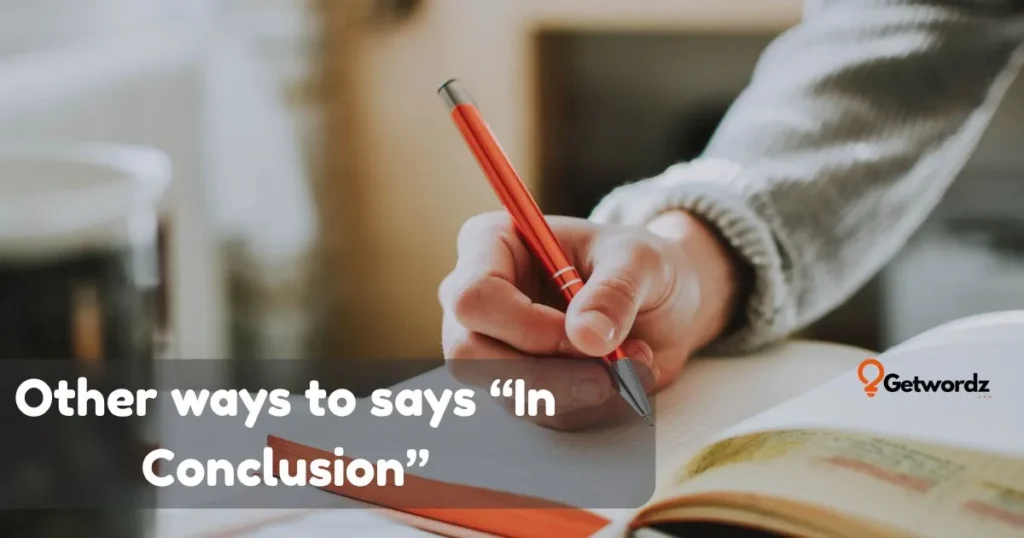The phrase “in conclusion” is one of the most common ways to end a paragraph essay or presentation but it’s also one of the most overused. Whether you’re writing an email to your boss finishing a report or wrapping up a blog post saying “in conclusion” can feel plain and predictable.
That’s why so many people look for different ways to say “in conclusion” that sound natural, engaging and professional. The right closing phrase can make your message feel polished and memorable instead of repetitive.
In this post you’ll find creative alternatives, unique expressions and better wording choices that work for every situation, whether you’re speaking to friends, colleagues, family or your partner.
As someone who has written and edited countless messages, I know how much a strong ending matters. Let’s explore some fresh, smart and memorable ways to say “in conclusion” that make your final words stand out.
1. To Sum It Up
Scenario:
You’ve just finished writing a blog post about productivity tips and need a smoother way to end your thoughts. Instead of saying “in conclusion” you choose “to sum it up” for a friendlier and more conversational finish.
Explanation:
“To sum it up” is a casual easy-to-understand phrase that works well in everyday writing or informal presentations. It’s a better way to say “in conclusion” when you want to sound approachable and natural. This creative alternative signals that you’re summarizing your main idea without sounding robotic or repetitive.
Examples:
- To sum it up this project taught us how teamwork really drives success.
- To sum it up, remember that consistency is more powerful than motivation.
- To sum it up, it’s the little daily habits that shape big results.
Why It Works:
This phrase stands out for its clarity and warmth. It feels genuine and conversational while keeping your writing easy to follow. It’s one of the most versatile alternatives to “in conclusion” because it fits both spoken and written communication naturally.
2. All Things Considered
Scenario:
You’re wrapping up a research essay comparing different marketing strategies. You want a transition that sounds more formal and analytical than “in conclusion.”
Explanation:
“All things considered” has a balanced professional tone that signals you’ve weighed every angle before presenting your final thoughts. It’s a unique expression that gives authority and depth to your summary perfect for essays, reports and academic writing.
Examples:
- All things considered, the new campaign proved more cost-effective than expected.
- All things considered teamwork still outperformed individual efforts.
- All things considered remote work continues to boost employee satisfaction.
Why It Works:
It’s a smart alternative that shows critical thinking and maturity. This phrase helps you wrap up arguments persuasively while keeping the tone formal yet natural.
3. Wrapping Things Up
Scenario:
You’re ending a friendly podcast episode or a social media video. Instead of sounding stiff with “in conclusion” you go for “wrapping things up” to keep the tone light and conversational.
Explanation:
This casual phrase works best in spoken or creative contexts where you’re connecting with your audience. It’s a fun alternative that feels modern and engaging, a great way to signal the end without losing energy.
Examples:
- Wrapping things up I just want to thank everyone for tuning in today.
- Wrapping things up, remember to stay consistent with your goals.
- Wrapping things up I hope these insights help you start your week strong.
Why It Works:
It’s approachable and easy to remember. This phrase gives your ending a friendly and conversational finish making it perfect for videos, blogs or informal presentations.
4. In Short
Scenario:
You’re summarizing a client proposal and want a quick professional way to restate your main idea. Instead of “in conclusion” you write “in short” for a crisp and confident close.
Explanation:
“In short” is a concise and direct alternative that works well in both business and academic settings. It signals you’re offering a brief summary without unnecessary filler ideal for busy readers who value clarity.
Examples:
- In short, our goal is to simplify user experience without losing functionality.
- In short, the results prove our strategy is on the right track.
- In short, quality always wins over quantity in long-term success.
Why It Works:
It’s clear, sharp and professional. Readers instantly understand you’re wrapping up. This different wording keeps your conclusion neat and focused perfect for reports and summaries.
5. To Wrap It All Up
Scenario:
You’re giving a motivational talk and want your ending to feel energetic rather than repetitive. Saying “to wrap it all up” makes your final words sound confident and complete.
Explanation:
This phrase carries a friendly motivational tone. It’s a creative alternative to “in conclusion” that adds rhythm and flow to your closing remarks.
Examples:
- To wrap it all up, success is built on small daily choices.
- To wrap it all up, always stay curious and keep learning.
- To wrap it all up, kindness will always take you further than competition.
Why It Works:
It’s memorable and expressive. This phrase works great for speeches, blogs and videos where you want to leave your audience feeling inspired and satisfied.
6. Overall
Scenario:
You’ve written a detailed report comparing several business models and now need to bring your findings together in one final thought. You choose “overall” to create a balanced and professional conclusion.
Explanation:
“Overall” is a neutral and polished alternative to “in conclusion.” It works especially well in business writing and analytical essays. It’s a creative wording choice that helps you summarize your key message while maintaining a professional and concise tone.
Examples:
- Overall the campaign exceeded expectations and boosted engagement rates.
- Overall it was a productive year full of meaningful progress.
- Overall teamwork played a major role in achieving our goals.
Why It Works:
It’s short, clear and flexible. This unique expression helps you sound confident and organized making your writing easy to follow.
7. Ultimately
Scenario:
You’re finishing a persuasive essay or speech and want to highlight your main point with confidence. Using “ultimately” gives your closing statement more impact.
Explanation:
“Ultimately” is a strong and decisive phrase that suggests finality. It’s a better way to say “in conclusion” when you want to emphasize your main message or final takeaway.
Examples:
- Ultimately success depends on how consistent you are with your efforts.
- Ultimately we learned that honesty builds the strongest teams.
- Ultimately the results spoke louder than any words could.
Why It Works:
It adds authority and emphasis. This phrase is great for persuasive writing because it clearly signals your final verdict or insight.
Read More: 30 Other Ways to Say “Good” With Examples!
8. On the Whole
Scenario:
You’re closing an academic paper or article where you’ve presented data and contrasting points. You use “on the whole” to show balance and fairness in your summary.
Explanation:
“On the whole” is a formal and balanced phrase that shows you’ve considered all perspectives. It’s a different wording choice that works beautifully in essays, reports or research writing.
Examples:
- On the whole the results supported our initial hypothesis.
- On the whole students responded positively to the new system.
- On the whole the event was well organized and effective.
Why It Works:
This phrase conveys thoughtfulness and professionalism. It’s ideal for when you want your conclusion to sound reflective rather than rushed.
9. In Summary
Scenario:
You’re ending a presentation and want to clearly restate your key takeaways. Instead of “in conclusion” you say “in summary.”
Explanation:
“In summary” is a classic and polished alternative that’s perfect for formal writing emails and speeches. It provides clarity and structure signaling a neat wrap-up of your main ideas.
Examples:
- In summary our strategy focuses on customer satisfaction and quality service.
- In summary, communication is the foundation of strong teamwork.
- In summary, persistence often matters more than talent.
Why It Works:
It’s professional and universally understood. This phrase helps you summarize efficiently without sounding repetitive or overly formal.
10. As a Final Point
Scenario:
You’re giving a talk and want to smoothly lead into your last message. Saying “as a final point” keeps your audience attentive until the end.
Explanation:
This phrase feels formal yet approachable. It’s a creative alternative to “in conclusion” that prepares readers or listeners for your closing thoughts.
Examples:
- As a final point, always believe in your ability to improve.
- As a final point, remember that patience pays off in the long run.
- As a final point teamwork will always beat individual effort.
Why It Works:
It’s clearly organized and audience-friendly. This unique expression works perfectly in speeches and presentations.
11. To Conclude
Scenario:
You’re finishing a formal essay or a business presentation. You use “to conclude” to mark your closing argument clearly.
Explanation:
“To conclude” is a direct and professional way to end any structured piece of writing. It’s one of the most effective alternatives to “in conclusion” when you want precision and authority.
Examples:
- To conclude, our findings prove that innovation drives growth.
- To conclude, teamwork remains our greatest strength.
- To conclude this year’s progress exceeded expectations.
Why It Works:
It’s formal, clear and universal. Ideal for academic or business contexts where you need a direct summary.
12. In Closing
Scenario:
You’re delivering a motivational speech and want to signal the end while keeping the energy alive. Saying “in closing” creates a smooth transition to your final thought.
Explanation:
“In closing” is a polished and versatile phrase used in both speeches and written pieces. It’s a better wording choice that gives your ending a sense of completeness.
Examples:
- In closing I want to thank everyone who contributed to this success.
- In closing, always remember progress takes patience.
- In closing let’s commit to staying focused and united.
Why It Works:
It’s professional yet heartfelt. This expression helps you close confidently while keeping a warm tone.
15. At the End of the Day
Scenario:
You’re summarizing a personal or reflective piece and want to leave a thoughtful impression. “At the end of the day” does the job perfectly.
Explanation:
This common conversational phrase adds a human touch to your closing. It’s a different way to say “in conclusion” that sounds natural and reflective.
Examples:
- At the end of the day honesty is always the best strategy.
- At the end of the day what matters most is happiness.
- At the end of the day effort beats excuses.
Why It Works:
It’s relatable and emotional. Perfect for personal writing or motivational content.
14. Long Story Short
Scenario:
You’re telling a story or sharing an experience and want to end it in a light relatable way. You use “long story short” to wrap things up humorously.
Explanation:
This phrase is casual and funny making it a unique expression for informal writing, storytelling or social media. It’s not ideal for formal writing but great for creative contexts.
Examples:
- Long story short we learned our lesson the hard way.
- Long story short the trip turned out better than expected.
- Long story short I finally got the job I wanted.
Why It Works:
It’s playful, modern and engaging. This phrase keeps your writing relatable and full of personality.
15. At the End of the Day
Scenario:
You’re summarizing a personal or reflective piece and want to leave a thoughtful impression. “At the end of the day” does the job perfectly.
Explanation:
This common conversational phrase adds a human touch to your closing. It’s a different way to say “in conclusion” that sounds natural and reflective.
Examples:
- At the end of the day honesty is always the best strategy.
- At the end of the day what matters most is happiness.
- At the end of the day effort beats excuses .
Why It Works:
It’s relatable and emotional. Perfect for personal writing or motivational content.
16. In Essence
Scenario:
You’re finishing an analytical article and want to restate your main point in a refined way. You go with “in essence.”
Explanation:
“In essence” is a formal and elegant phrase that summarizes the core of your message. It’s a creative alternative that adds sophistication to your conclusion.
Examples:
- In essence our research confirms that trust builds loyalty.
- In essence creativity is problem-solving in disguise.
- In essence leadership is about service not control.
Why It Works:
It’s concise and intellectual, making it perfect for academic and business writing.
17. Simply Put
Scenario:
You’re explaining something complex and want to wrap it up clearly. “Simply put” helps you restate your point in an easy-to-grasp way.
Explanation:
This straightforward phrase is great for simplifying information. It’s a better wording choice that fits articles, blogs and tutorials.
Examples:
- Simply put, success comes from steady effort.
- Simply put, teamwork makes big goals possible.
- Simply put, growth takes time and patience.
Why It Works:
It’s clear, approachable and practical. Great for content that aims to educate or explain.
18. The Bottom Line
Scenario:
You’re ending a persuasive or motivational article. You want to sound strong and confident so you use “the bottom line.”
Explanation:
This direct and impactful phrase delivers your key point with authority. It’s a powerful alternative to “in conclusion.”
Examples:
- The bottom line success favors those who keep going.
- The bottom line is communication builds trust.
- The bottom line quality always wins.
Why It Works:
It’s bold and memorable, perfect for business writing and opinion pieces.
19. To Wrap It Up
Scenario:
You’re ending a friendly presentation or blog post and want your conclusion to feel light and conversational. “To wrap it up” keeps it casual and engaging.
Explanation:
This phrase is a warm and informal alternative to “in conclusion.” It’s perfect for creative writing, lifestyle blogs, or videos where a relaxed tone fits best.
Examples:
- To wrap it up, keep learning and improving every day.
- To wrap it up a little gratitude can go a long way.
- To wrap it up, teamwork makes everything possible.
Why It Works:
It’s friendly, flexible, and easy to relate to. Perfect for conversational writing that still ends with clarity and purpose with clarity and purpose.
20. To Sum Up
Scenario:
You’re finishing a short report or review and want to close quickly without sounding too formal. “To sum up” gives you a simple, direct transition.
Explanation:
“To sum up” is a clean and concise phrase that makes summarizing effortless. It’s a better wording option that keeps your writing crisp and focused.
Examples:
- To sum up, our plan is simple but effective.
- To sum up, we learned valuable lessons this quarter.
- To sum up, the project exceeded all expectations.
Why It Works:
It’s brief yet professional. This phrase delivers closure efficiently and keeps your writing well-organized.
21. All in All
Scenario:
You’re reflecting on an experience or story and want to leave a positive impression. You choose “all in all” for a natural wrap-up.
Explanation:
“All in all” is a casual and conversational phrase often used in storytelling or informal writing. It’s a creative alternative to “in conclusion” that feels relaxed and personal.
Examples:
- All in all it was a trip full of laughter and memories.
- All in all the team did an excellent job.
- All in all we learned a lot from the experience.
Why It Works:
It’s warm and genuine. This phrase helps you connect emotionally with readers while still wrapping things up neatly.
22. In Short
Scenario:
You’re summarizing your point for busy readers who just want the takeaway. “In short” helps you condense your conclusion effectively.
Explanation:
“In short” is a clear and efficient phrase that works well in blogs, summaries, and opinion pieces. It’s a different wording choice that signals a quick, to-the-point wrap-up.
Examples:
- In short, preparation is the key to success.
- In short, consistency beats intensity every time.
- In short, passion turns effort into excellence.
Why It Works:
It’s concise and attention-friendly. Perfect for digital writing where readers prefer quick insights.
23. As We’ve Seen
Scenario:
You’re closing a detailed article or analysis and want to remind readers of what they’ve learned. “As we’ve seen” transitions smoothly into your summary.
Explanation:
This phrase is formal yet conversational, great for essays and professional content. It’s a better way to say “in conclusion” when you want to refer back to your discussion naturally.
Examples:
- As we’ve seen, teamwork leads to stronger results.
- As we’ve seen small habits make a big difference.
- As we’ve seen, clear communication prevents misunderstandings.
Why It Works:
It’s reflective and cohesive. It ties your argument together while gently leading the reader to your closing thought.
24. To Put It Briefly
Scenario:
You’re writing a blog summary or a speech and want your final line to be concise. “To put it briefly” helps you end with clarity and style.
Explanation:
This is a simple and effective phrase that keeps your writing focused. It’s a creative alternative to “in conclusion” when you want to summarize quickly.
Examples:
- To put it briefly, preparation brings confidence.
- To put it briefly, balance is the secret to long-term success.
- To put it briefly, gratitude changes everything.
Why It Works:
It’s smooth and versatile. This phrase helps you close your content with elegance and precision.
25. In a Nutshell
Scenario:
You’re explaining a long topic and want to wrap it up in one catchy line. “In a nutshell” helps you do that effortlessly.
Explanation:
“In a nutshell” is a friendly, idiomatic expression that adds charm to your summary. It’s a unique expression often used in informal or conversational writing.
Examples:
- In a nutshell teamwork and trust make success possible.
- In a nutshell, success requires effort and patience.
- In a nutshell leadership is about serving others.
Why It Works:
It’s catchy, memorable, and natural. Readers easily connect with its familiar tone, making your conclusion enjoyable and effective.
26. To Bring It All Together
Scenario:
You’re finishing a long presentation or written report that covered several points. You say “to bring it all together” to show how each idea connects before ending your discussion.
Explanation:
This phrase is a friendly and natural alternative to “in conclusion.” It emphasizes unity and organization, helping readers or listeners see the bigger picture. It’s a creative expression often used in educational, leadership, and motivational contexts.
Examples:
- To bring it all together teamwork remains the foundation of every success.
- To bring it all together our findings prove that innovation drives growth.
- To bring it all together, clear goals make every effort more meaningful.
Why It Works:
It’s inclusive, clear, and cohesive. This phrase signals closure while showing that all points link to a shared conclusion, making it great for structured writing or presentations.
27. To Put It Simply
Scenario:
You’re explaining a complex subject and want your audience to leave with one easy takeaway. You choose “to put it simply” to restate your idea in plain words.
Explanation:
“To put it simply” is a straightforward and conversational phrase that simplifies your conclusion. It’s a better wording choice for blog posts, how-to guides, and explanations.
Examples:
- To put it simply, effort and patience create long-lasting results.
- To put it simply, good communication builds strong relationships.
- To put it simply, preparation prevents poor performance.
Why It Works:
It’s friendly and easy to digest. This phrase helps readers grasp your final message clearly without any confusion or heavy wording.
Read More: 30 Other Ways to Say “Proud of You” with Examples!
28. To Sum Things Up
Scenario:
You’re closing a discussion, online post, or podcast and want to summarize everything in one line. You go with “to sum things up” to sound conversational but complete.
Explanation:
“To sum things up” is a natural and widely used expression that works across informal and semi-formal contexts. It’s a creative alternative to “in conclusion” that keeps your tone approachable.
Examples:
- To sum things up, passion makes the difference between good and great.
- To sum things up, small daily actions create big life changes.
- To sum things up, progress starts when you take the first step.
Why It Works:
It’s easygoing yet organized. This phrase lets you close smoothly while keeping your writing or speech engaging and down-to-earth.
29. All Things Considered
Scenario:
You’ve analyzed pros and cons in your essay or report and want to provide a balanced summary. You say “all things considered” to show fair judgment in your conclusion.
Explanation:
“All things considered” is a formal and thoughtful phrase that works beautifully in essays, research papers, or analytical discussions. It’s a different way to say “in conclusion” while adding professionalism.
Examples:
- All things considered, the new system improved productivity overall.
- All things considered, our strategy delivered strong long-term results.
- All things considered it was a challenging but rewarding experience.
Why It Works:
It’s balanced, mature, and objective. This phrase reflects critical thinking and helps your conclusion sound credible and well-reasoned.
30. To Wrap Things Up
Scenario:
You’re ending a friendly meeting, podcast, or vlog and want a casual but clear closing line. “To wrap things up” feels natural and conversational for such moments.
Explanation:
This phrase is a relaxed and positive alternative to “in conclusion.” It’s a unique expression that keeps your communication personable and confident.
Examples:
- To wrap things up, always end your day with gratitude.
- To wrap things up, remember that progress takes patience.
- To wrap things up, stay curious and keep learning something new.
Why It Works:
It’s warm, conversational, and memorable. This phrase helps you finish naturally while keeping your tone friendly, professional, and engaging.
Pros✅and Cons❌of Using In Conclusion
pros✅
- Clearly signals that your writing or speech is coming to an end
- Works perfectly for essays, academic papers, and formal reports
- Helps maintain an organized and logical flow in your message
- Easy for readers to recognize and understand your final thoughts
Cons❌
- Can sound repetitive or overly formal in casual communication
- Makes your writing feel predictable or less engaging if overused
- May not fit creative or conversational tones like blogs or social media posts
- Lacks personality compared to creative alternatives.
Closing words
Finding fresh alternatives to the familiar phrase in conclusion helps you close thoughts with more style, clarity, and impact. Instead of repeating the same overused ending, you now have creative expressions and unique wording that feel natural while keeping your message engaging.
You can try these different ways to say it when writing to colleagues, posting on social media, or adding thoughtful lines to cards and notes. These creative alternatives let your closing remarks stand out with fresh wording that feels intentional and sincere.
So the next time you wrap up an idea, try one of these phrases in your message, it may surprise you how much more authentic and impactful your words sound. By using new endings, you elevate communication and leave a lasting impression.
And remember: choosing the right words makes your writing memorable, even when it’s simply saying in conclusion.




